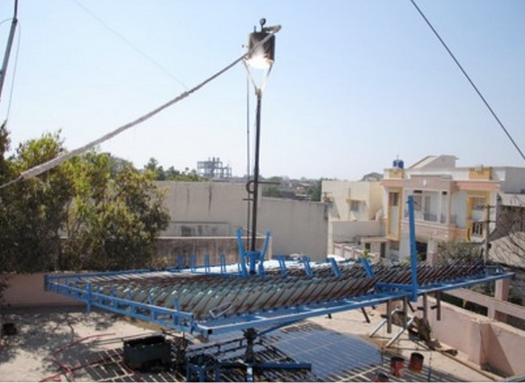I’ve written before about the #4T2 project by Kennisnet. A while back I was interviewed by Wietse van Bruggen about a concept, society as a learning platform, that we brainstormed in a small subgroup. Below in Dutch what we discussed. You can find the original here.
Tijdens de #4T2 brainstorm op 22 juni hebben de leden van de denktank hun ideeën gepitcht en samen de meest kansrijke concepten uitgewerkt. Dit zijn concrete innovatie-activiteiten die het innovatie team van Kennisnet in het programma voor 2013 gaat opnemen.
Eén daarvan betreft de ‘maatschappij als platform voor het leren’, een idee dat is uitgedacht door Niels Gouman, Hans de Zwart, Iris van Gelder, Thijmen Stavenuiter, Frida Hengeveld en Wietse van Bruggen. In dit model wordt er binnen een soort online marktplaats een match gemaakt tussen vraag en aanbod. De maatschappij wordt daarbij gezien als de bron voor kennis en competenties. Iedereen in de maatschappij zou deze kunnen aanbieden aan lerenden. Wietse van Bruggen sprak over dit concept met #4T2-lid Hans de Zwart.

Kun je kort het idee uitleggen?
De basis van het idee is het ontscholen van de maatschappij, het demonopoliseren van de school als enige instituut waar het leren plaatsvindt. Met behulp van technologie zou2e de gehele maatschappij als platform voor het leren moeten kunnen fungeren. Met behulp van vouchers die de overheid geeft aan individuele leerlingen kunnen zij zelf beslissen voor welke skills, vaardigheden en kennis ze een voucher willen inzetten. Technologie moet helpen door als een soort makelaar te fungeren tussen vraag en aanbod. Iedereen in de maatschappij zou op een platform kenbaar kunnen maken welke skills, competentie of kennis ze iemand kunnen bijbrengen. Afhankelijk van de leervraag van de lerende kan er dan een match gemaakt worden tussen vraag en aanbod.
Als je bijvoorbeeld Japans wilt leren, dan zou je in plaats van een opleiding Japans te volgen ervoor kunnen kiezen bijvoorbeeld in een sushi restaurant aan de slag te gaan en daar Japans te leren van de koks. Of te kijken bij andere organisaties, bedrijven of individuen waar je deze skill op kan doen. Iedereen in de maatschappij kan iets bijdragen in dit systeem.
Daarnaast heeft iedere lerende een coach. Zeker voor jonge kinderen is er iemand nodig die je tot op zekere hoogte monitort, leert kennen en het brede perspectief voor blijft houden. Deze coach kan middels technologie inzichtelijk houden waar een leerling staat (ook wel learning analytics genoemd).
Wat is de onderliggende behoefte?
Met dit model kan je veel gerichter aansluiten op de behoefte van de leerling zelf. Daar sluit je nauwer op aan en het zou een efficiëntere manier van leren met diepgang kunnen zijn. Scholen zijn traditioneel gezien gericht op massa en niet op personalisatie. Door het individu veel centraler te stellen kan je veel beter gepersonaliseerd onderwijs verzorgen.
Wat verandert er door dit idee?
Als je dit echt gaat doen dan heb je het over een structurele verandering van onze maatschappij. Functies die scholen nu hebben plaats je terug in organisaties, bedrijfsleven en andere instellingen. Vakspecifieke docenten heb je eigenlijk niet nodig in dit model. Voor heel jonge kinderen zul je nog een schoolachtige omgeving willen organiseren. Maar een klassieke invulling van vakken is er niet. De lerende en de skills, competenties en kennis staan centraal, en daarom is iets als een vak niet relevant.
Welke vraag of probleem wordt hier door opgelost?
Het is een oplossing voor de steeds groter wordende disconnect tussen wat er op school en daarbuiten gebeurt. De manier waarop leerlingen communiceren, buiten school werken en bezig zijn is fundamenteel anders dan op school. Het feit dat je als leerling je telefoon soms moet uitzetten of zelfs inleveren op school is daar een symptoom van.
Welke actie zou je nu kunnen ondernemen?
Je zou kunnen spelen met het idee van een makelaar op het gebied van skills en leerervaringen. Hoe zou je een soort matchmaker machine kunnen maken die dit mogelijk maakt? Het is echter ook moeilijk om dit klein aan te pakken, omdat het zo allesomvattend is. Wat je zou kunnen doen is proberen om leerervaringen buiten school te creëren en te organiseren in plaats van dit gelijk in de realiteit van het huidige onderwijsmodel proberen uit te voeren. Het model zorgt er namelijk voor dat je heel veel dingen los moet laten. Dat kan voor scholen moeilijk zijn om te doen. Leuke voorbeelden om van af te kijken zijn bijvoorbeeld learnable.com, udemy.com en skillshare.com.
Wat gaat Kennisnet Innovatie in 2013 doen met dit concept/idee?
Kennisnet organiseert een brainstorm met potentiële partijen die aanbod kunnen bieden binnen dit model en learners, de vragenstellers binnen dit model, om het vraagstuk verder op te pakken en de werking van het marktplaats model verder uit te werken. Daarbij maken we gebruik van de ervaringen uit bestaande vergelijkbare initiatieven.
